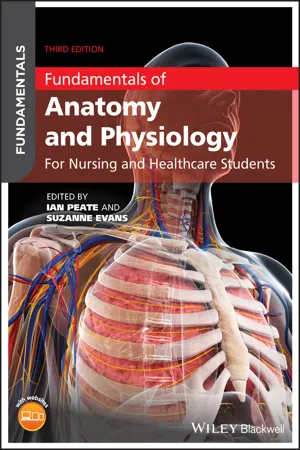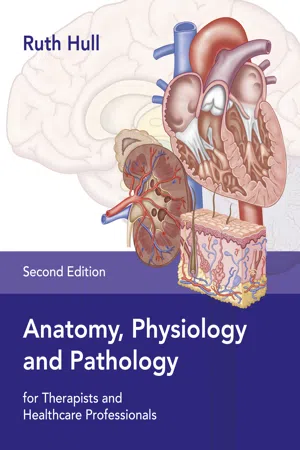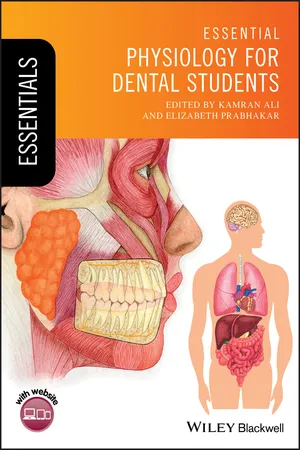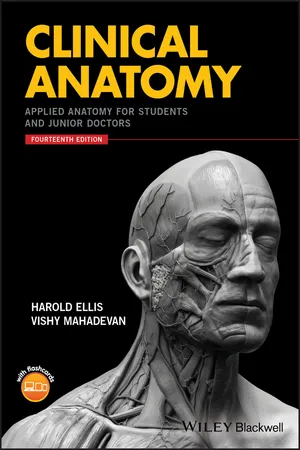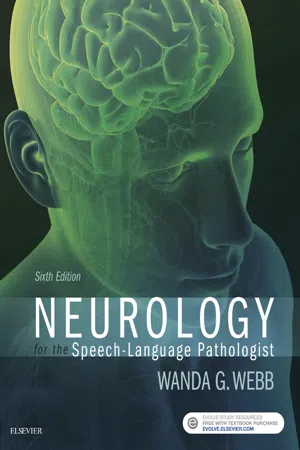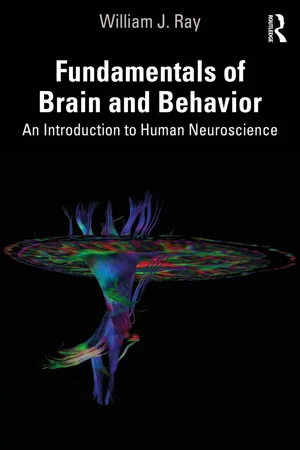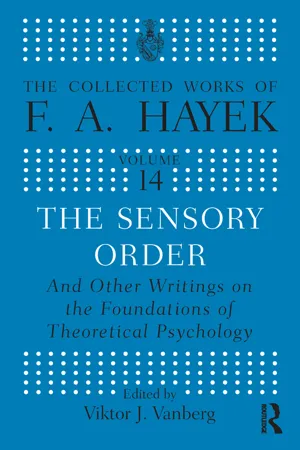Psychology
Nervous System Divisions
The nervous system is divided into the central nervous system (CNS) and the peripheral nervous system (PNS). The CNS consists of the brain and spinal cord, while the PNS includes all the nerves outside the CNS. The PNS further divides into the somatic and autonomic nervous systems, which control voluntary and involuntary bodily functions, respectively.
Written by Perlego with AI-assistance
Related key terms
Related key terms
1 of 4
Related key terms
1 of 3
10 Key excerpts on "Nervous System Divisions"
- eBook - ePub
Fundamentals of Anatomy and Physiology
For Nursing and Healthcare Students
- Ian Peate, Suzanne Evans, Ian Peate, Suzanne Evans(Authors)
- 2020(Publication Date)
- Wiley-Blackwell(Publisher)
The nervous system interacts with all of the systems of the body. This system is large and complex. In order to facilitate understanding of the nervous system it has to be divided into smaller functional and anatomical parts. This chapter outlines the divisions of the nervous system; it discusses the structure and function of the nervous system and how it influences other structures of the body. Having such an important role in maintaining homeostasis, the nervous system possesses additional protection, and that too will be investigated.Organisation of the Nervous System
The nervous system can be divided into two parts: the central nervous system and the peripheral nervous system. The central nervous system consists of the brain and spinal cord and is the control and integration centre for many body functions.The peripheral nervous system carries sensory information to the central nervous system and motor information out of the central nervous system. The direction of information flow to and from the nervous system is important and is shown in Figure 14.1 .Organisation of the nervous system.Figure 14.1Sensory Division of the Peripheral Nervous System
Sensory information (stimuli) is gathered from both inside and outside of the body. This sensory input is delivered to the central nervous system via the peripheral nerves. Sensory nerve fibres are also called afferent fibres. Sensory information always travels from the peripheral nervous system towards the central nervous system. There are many different kinds of sensory information, including pain, pressure, temperature, chemical levels and more. Consider the maintenance of body temperature. As warm‐blooded animals, it is important that body temperature is maintained between 36.5 and 37.5 °C. Temperature receptors in the skin called thermoreceptors detect changes in temperature, and as temperature changes have the potential to cause damage to cells and tissues, this information must be relayed to the central nervous system and, if required, acted upon. - eBook - ePub
- Ruth Hull(Author)
- 2021(Publication Date)
- Lotus Publishing(Publisher)
You may have heard people talking about the ‘central nervous system’ or the ‘autonomic nervous system’ or the ‘parasympathetic nervous system’ and wondered what exactly is going on. In fact, you may be wondering exactly how many nervous systems you really have. The answer is simple: you only have one nervous system. But, because it is such a complex system, it is divided into a number of different parts. What is important here, before we go any further, is that you understand that all these different parts function together as one coordinated system.Now let us look at all these divisions. To begin with, the nervous system is divided into the central nervous system (CNS ) and the peripheral nervous system (PNS ). The PNS is then subdivided into the somatic and autonomic nervous systems . The autonomic nervous system is then divided into the sympathetic and parasympathetic nervous systems .Central nervous systemThe CNS is made up of the brain and spinal cord. It functions in analysing and storing information, making decisions, and issuing orders. It is where memories are made and stored, emotions generated, and thoughts conceived. We will study the brain and spinal cord in detail later in this chapter.Peripheral nervous system The PNS is made up of nerve cells that reach every part of the body, and consists of:• Cranial nerves: Cranial nerves arise from the brain and carry impulses to and from the brain.• Spinal nerves: Spinal nerves emerge from the spinal cord to carry impulses to and from the rest of the body. Spinal nerves contain two types of nerve cells (neurons):– Sensory (afferent) neurons: Sensory, or afferent, neurons conduct impulses from sensory receptors to the CNS.– Motor (efferent) neurons: Motor, or efferent, neurons conduct impulses from the CNS to muscles and glands.The PNS is subdivided into the somatic nervous system (SNS) and the autonomic nervous system (ANS). Somatic nervous systemFigure 6.3 Divisions of the nervous systemThe word soma means ‘body’, and the SNS allows us to control our skeletal muscles. Thus, it is sometimes also called the voluntary nervous system - eBook - ePub
- Kamran Ali, Elizabeth Prabhakar, Kamran Ali, Elizabeth Prabhakar(Authors)
- 2018(Publication Date)
- Wiley-Blackwell(Publisher)
PART IX Nervous SystemPassage contains an image
CHAPTER 21 Central Nervous System
Elizabeth Prabhakar and Kamran AliIntroduction
The nervous system (NS ) is a rapid communication system which controls the biological processes in the body. It serves as a processing centre for the integration of sensory, motor, and visceral function as well as higher‐order functions such as emotion, thought, learning, memory, and intelligence.The NS is composed of two main types of cells: neurons and neuroglia. Neurons are excitable cells involved in the reception and conduction of nerve signals (Chapter 2 ). The second type are the non‐excitable supporting cells collectively known as neuroglial cells. The latter include: astrocytes, which are star‐shaped cells involved in the transport of neurotransmitters; oligodendrocytes, which produce the myelin sheath for neurons in the brain and spinal cord (the myelin sheath for peripheral neurons is provided by Schwann cells); microglia, which have a phagocytic function; and ependymal cells, which line the ventricles of the brain.The functional unit of the NS is the neural network (composed of individual neurons), because even the most basic functions require a circuit of neurons. An estimated 86–100 billion neurons link together to form extensive and intricate networks, which converge and diverge into producing myriad possible signalling pathways.Divisions of the Nervous System
The NS can be divided into the central nervous system (CNS) and the peripheral nervous system (PNS). The CNS comprises the brain and spinal cord and the PNS comprises all nervous tissue lying outside the CNS. These include the cranial and spinal nerves, emanating from the spinal cord, autonomic ganglia, enteric plexuses, and sensory receptors in the skin (Figure 21.1 ).Figure 21.1 - eBook - ePub
Clinical Anatomy
Applied Anatomy for Students and Junior Doctors
- Harold Ellis, Vishy Mahadevan(Authors)
- 2018(Publication Date)
- Wiley-Blackwell(Publisher)
Part 6 The Nervous SystemIntroduction
For descriptive purposes, the nervous system can be divided, topographically, into two parts: the central nervous system and the peripheral nervous system.The central nervous system comprises the brain and spinal cord, which are located, respectively, in the cranial cavity and the vertebral (spinal) canal, and are continuous with each other at the foramen magnum (where the medulla oblongata of the brain stem adjoins the spinal cord).The peripheral nervous system comprises the twelve pairs of cranial nerves, thirty‐one pairs of spinal nerves, the ganglia associated with the cranial and spinal nerves, and the right and left ganglionated sympathetic chains.This division into central and peripheral systems is somewhat arbitrary, as the two ‘systems’ are physically connected and normally function in an integrated and co‐ordinated manner.The brain
On a functional basis, the brain may be pictured as being made up of four major divisions:- brainstem (comprising, from below upwards, the medulla oblongata, pons and midbrain);
- cerebellum;
- diencephalon (comprising, mainly, the thalamus and hypothalamus);
- cerebral hemispheres.
By another convention, based on embryological development, the brain may be divided into the forebrain (comprising the cerebral hemispheres and diencephalon), midbrain and hindbrain (made up of the pons, medulla oblongata and cerebellum).The brainstem
Extending from just above the tentorial hiatus to just below the foramen magnum, the brainstem is a stalk‐like structure that is continuous superiorly with the diencephalon, and inferiorly with the spinal cord. As has been stated previously, the brainstem and the cerebellum are situated in the posterior cranial fossa. - eBook - ePub
Mental Life
An Introduction to Psychology
- Beatrice Edgell(Author)
- 2014(Publication Date)
- Psychology Press(Publisher)
CHAPTER III THE BUILD AND FUNCTIONS OF THE NERVOUS SYSTEMWE may regard the nervous system as representing the unity of the body, bringing its different parts and organs into relation with one another. (See Fig. 1 .)In man the nervous system is made up of two parts: (1) the Central Nervous system, and (2) the Peripheral Nervous system. The first part consists of the brain within the skull and the spinal cord running through the spinal canal in the vertebral column. The second system consists of the Cerebro-spinal (Somatic) nerves and the Autonomic (Visceral) nerves. The latter comprises (a ) nerves right and left of the vertebral column on the ventral side, (b ) ganglia, or collections of nerve cells, in connexion with the viscera, i.e. circulatory, respiratory, digestive, and reproductive organs.The nerves connected with the exterior sensory receptors and those which are connected with the voluntary muscles belong to the Somatic group. The nerves belonging to the involuntary or smooth muscles carrying out movements in the interior of the body belong to the Autonomic system. Briefly, we may say the Somatic nerves are concerned with the reception of stimulation from the external world and with voluntary response thereto, while the Autonomic or Sympathetic system is concerned with the vital functions of the body. Though anatomically connected with the nerves of the spinal cord, the Autonomic system is to some extent capable of functioning independently ; hence its name, Autonomic.THE STRUCTURE OF THE NERVOUS SYSTEM(i) General Plan . —The simplest picture which we can form of a mechanism which can receive and respond to stimulation is that of a single cell having a contractile process.FIG . 1.—GENERAL VIEW OF THE NERVOUS SYSTEM , SHOWING BRAIN, CORD , AND NERVEG (from Martin’s “Human Body”)This fragment of specialized protoplasm, with its nucleus, is capable of being excited by its environment, e.g. irritated by contact, and of responding to this excitation by contraction of its process. It can also respond in the same manner to changes within its own economy. - Wanda Webb, Richard K. Adler(Authors)
- 2016(Publication Date)
- Mosby(Publisher)
23Foundations of the Nervous System
Chapters 2 and 3 provide an overview of the anatomy and physiology of the human nervous system. After discussing the “building blocks” of the nervous system, this text takes a “top-down” approach to the gross anatomy, beginning with the cortex and ending with the spinal cord anatomy. This organization was chosen because as human beings, cortical processing and control are vital to all but the most basic motor, cognitive, and emotional functions. It is not your ears that hear; it is really your brain. Your thoughts are initiated through cortical networks. Your memories and their associated emotions are stored in your brain. Therefore it seems appropriate to start with the “boss” and work our way down the organizational ladder of the nervous system in order to understand it better. Before we begin looking more closely at the individual structures of the brain and spinal cord, however, a study of the microstructure and foundation of this miraculous nervous system of ours will be helpful for understanding the complex function of the larger structures.Anatomically, the human nervous system has two major divisions: the central nervous system (CNS) and the peripheral nervous system (PNS). The CNS, also called the neuraxis, consists of the brain and spinal cord. Two types of nerves are found within both systems, the cranial and the spinal nerves, and their ganglia . The term ganglia refers to the masses of nerve cell bodies associated with the particular nerve and located as an enlargement on that nerve or at the juncture or separation point of that nerve with another peripheral nerve. The nerves of the PNS connect the brain and spinal cord with peripheral structures such as muscles, glands, and organs. Both divisions of the nervous system contain somatic parts that control bodily movements and innervate- eBook - ePub
Fundamentals of Brain and Behavior
An Introduction to Human Neuroscience
- William J. Ray(Author)
- 2024(Publication Date)
- Routledge(Publisher)
2 Functioning of the Nervous SystemDOI: 10.4324/9781003266426-2Learning Objectives
- Describe the neuron and how it is involved in communication in the brain and body.
- Explain the nature of neural networks and how they influence human behavior.
- Discuss the role of hormones and the endocrine system.
- Describe the major structures in the brain.
- Discuss the autonomic nervous system.
The Brain and Its Involvement in Behavior and Experience
The brain controls thoughts, feelings, and actions through the interaction of billions of neurons and glia (also called glial) cells (Lovinger et al., 2022 ). This is accomplished by a communication process in the brain that can either increase activity (excitatory) or decrease it (inhibitory). As you will see, the action potential which moves signals from one neuron to another is critical. Also, a chemical substance referred to as neurotransmitters plays an important role.In this chapter, we focus on the brain and the components of the nervous system. We also review the evolution of the neuron, which is the basic building block of organisms. Next, we look more closely at the structure of the brain. Finally, we review different networks of the brain and look at the evolution and development of the brain.An Enchanted Loom
Sir Charles Sherrington, the 1930s Nobel Prize winner for his groundbreaking work on reflexes, suggested that we view the brain as an enchanted loom. In saying this, he was referring to the manner in which the neurons in the brain become active and form patterns only to change these patterns as new processes become important. This metaphor helps us to realize that the brain is never constant but always changing. Sherrington saw these patterns as a dance (seeFigure 2-1).Figure 2-1The dance of the neurons—neurons in the brain—sometimes one is active then another.To understand how this dance relates to human behavior and experience, we look to the brain. The human brain weighs only about 3 pounds but uses some 20% of all the energy consumed by our body (see Magistretti, 2009 for an overview). Energy is supplied to the brain by a complex system supplying blood to the brain. As you will see when we discuss brain imaging in the chapter devoted to neuroscience methods of brain structure and function (Chapter 4 - F.A Hayek, Viktor J. Vanberg, Viktor J. Vanberg(Authors)
- 2017(Publication Date)
- Routledge(Publisher)
CHAPTER IIITHE NERVOUS SYSTEM AS AN INSTRUMENT OF CLASSIFICATION
1. An Inventory of the Physiological Data
3.1. Before we can attempt to state in greater detail the theory sketched in the preceding chapter, it will be necessary to take stock of the essential anatomical and physiological facts which we shall have to use as bricks from which to construct an apparatus of the kind we are seeking. For our purpose it will not be necessary to concern ourselves with the structure and the functioning of the central nervous system in any great detail. It will suffice if we briefly note certain general characteristics of its parts and of the processes taking place in them. The simplifications which we shall employ must be justified by the fact that our aim is not so much to elaborate a theory which is correct in every detail, as to show how any theory of this kind can account for the mental events with which we are concerned.3.2. According to an almost universally held view the nervous system is built up, like the rest of the organism, from a large number of separate cells. These cells, called neurons, consist of a cell body and two kinds of attaching processes, the axon and the dendrites. Although some doubt has recently been expressed concerning this ‘neuron theory’, and the alternative theory of an essential continuity of the system of nervous fibers has been put forward,1 we shall state the main facts in terms of the pre- dominant view, since confirmation of the alternative theory would not significantly affect the conclusions at which we arrive from the former. The main facts which we shall have to take into account may then be stated as follows:3.3. The cerebral cortex is the highest and most complex of several ‘bridges’ which connect the afferent fibers conducting impulses from the peripheral receptors, and the efferent fibers conducting impulses to the motor organs. We must thus conceive of the central nervous system (and probably also of the cortex itself ) as a hierarchy consisting of many superimposed levels of connections, all of which may be concerned in the transmission of impulses from the afferent (sensory) to the efferent (motor) fibers. This conception of a hierarchy of centers or levels does, of course, not imply that these levels can always be sharply separated, either structurally or functionally, or that they are superimposed upon each other in a simple linear order.- eBook - ePub
The Sensory Order
An Inquiry into the Foundations of Theoretical Psychology
- F. A. Hayek(Author)
- 2012(Publication Date)
- University of Chicago Press(Publisher)
CHAPTER IIITHE NERVOUS SYSTEM AS AN INSTRUMENT OF CLASSIFICATION1. AN INVENTORY OF THE PHYSIOLOGICAL DATA3.1. Before we can attempt to state in greater detail the theory sketched in the preceding chapter, it will be necessary to take stock of the essential anatomical and physiological facts which we shall have to use as bricks from which to construct an apparatus of the kind we are seeking. For our purpose it will not be necessary to concern ourselves with the structure and the functioning of the central nervous system in any great detail. It will suffice if we briefly note certain general characteristics of its parts and of the processes taking place in them. The simplifications which we shall employ must be justified by the fact that our aim is not so much to elaborate a theory which is correct in every detail, as to show how any theory of this kind can account for the mental events with which we are concerned.3.2. According to an almost universally held view the nervous system is built up, like the rest of the organism, from a large number of separate cells. These cells, called neurons, consist of a cell body and two kinds of attaching processes, the axon and the dendrites. Although some doubt has recently been expressed concerning this ‘neuron theory’, and the alternative theory of an essential continuity of the system of nervous fibres has been put forward,1 we shall state the main facts in terms of the predominant view, since confirmation of the alternative theory would not significantly affect the conclusions at which we arrive from the former. The main facts which we shall have to take into account may then be stated as follows:3.3. The cerebral cortex is the highest and most complex of several ‘bridges’ which connect the afferent fibres conducting impulses from the peripheral receptors, and the efferent fibres conducting impulses to the motor organs. We must thus conceive of the central nervous system (and probably also of the cortex itself) as a hierarchy consisting of many superimposed levels of connexions, all of which may be concerned in the transmission of impulses from the afferent (sensory) to the efferent (motor) fibres. This conception of a hierarchy of centres or levels does, of course, not imply that these levels can always be sharply separated, either structurally or functionally, or that they are superimposed upon each other in a simple linear order. - eBook - ePub
Physiological Psychology
An Introduction
- Simon Green(Author)
- 2016(Publication Date)
- Routledge(Publisher)
Fig. 2.2 ) is organized into a ventral nerve cord with paired nerves innervating (supplying) each segment. In vertebrates the nervous system consists of a brain at the head of a spinal cord, with paired spinal nerves leaving the cord to innervate the body. Thus an initial classification of the nervous system divides it into the central nervous system (CNS: the brain and the spinal cord) and the peripheral nervous system (PNS: the spinal nerves).Figure 2.2 Outline of earthworm nervous system – anterior end of body. Compare segmental arrangement with vertebrate peripheral nervous system (Fig. 2.3 )The peripheral nervous systemIn primates, the thirty-one pairs of spinal nerves carry hundreds of thousands of neuronal fibres, mainly axons. They can be carrying information from sensory receptors into the CNS (sensory or afferent), or carrying commands from the CNS out to response systems, or effector organs, such as muscles and glands (motor or efferent) (Fig. 2.3 ). The location and type of receptors and effectors is used to subdivide the PNS into two major systems. The somatic nervous system (SNS) includes those afferent pathways from touch, pain, pressure, and temperature receptors on the surface of the body and in muscles and joints, etc., and efferent motor pathways to the striped muscle of the skeleton. Sensory input from the complex sensory structures of the head (eyes, ears, the vestibular balance system of the inner ear) may also be seen as part of the SNS, whose overall role, in a simplified way, can be seen as enabling the regulation of the organism’s interactions with the external environment, i.e. it passes information from the outside world into the CNS and carries commands out from the CNS to skeletal muscle, providing movement.Figure 2.3 Outline organization of vertebrate peripheral nervous system. Each spinal nerve contains thousands of neuronal fibres – motor axons of the autonomic nervous system, innervating the heart, smooth muscle of intestine and blood vessels, and glands; motor axons of the somatic nervous system travelling to skeletal muscle, and sensoryfibres of the somatic nervous system carrying information from sensory receptors on the skin and in muscles and joints. The cranial nerves handle the sensory and motor functions of the head and anterior end of the body
Index pages curate the most relevant extracts from our library of academic textbooks. They’ve been created using an in-house natural language model (NLM), each adding context and meaning to key research topics.
Explore more topic indexes
Explore more topic indexes
1 of 6
Explore more topic indexes
1 of 4
